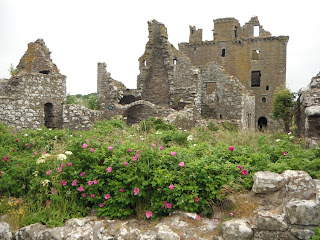With Carolyn’s Brother and his wife here in Edinburgh we took Friday
afternoon and all day on Saturday to visit more of this beautiful country.
Friday
afternoon we went into Edinburgh again to visit the Edinburgh Castle. The castle is truly amazing. Edinburgh Castle
is situated on Castle Rock in the city of Edinburgh. The Castle was built
during the 12th century and expanded over the next 500 years.
The tensions between the English and Scottish monarchies nearly always centred on Edinburgh Castle. He who held the castle held rule over the city of Edinburgh and, therefore, over all of Scotland. Consequently, the castle was almost constantly under siege. There were battles surrounding the castle from the late 13th century when Edward I of England attempted to seize the then vacant Scottish throne.
The tensions between the English and Scottish monarchies nearly always centred on Edinburgh Castle. He who held the castle held rule over the city of Edinburgh and, therefore, over all of Scotland. Consequently, the castle was almost constantly under siege. There were battles surrounding the castle from the late 13th century when Edward I of England attempted to seize the then vacant Scottish throne.
In 1571, English forces laid siege to the city of Edinburgh in an attempt to capture Mary, Queen of Scots. The castle again witnessed strife when in 1650, Oliver Cromwell executed Charles I and led an invasion of Scotland. During the Jacobite Risings (1688-1746), the Scots attempted, several times, to recapture their castle. Unfortunately, they were never able to overpower the English. The final attempt was in 1745 when the Jacobite army was led by Charles Edward Stuart (Bonnie Prince Charlie). Although the Scots were able to capture the city, they were never able to lay siege to the castle. The Scottish
Crown, sceptre and sword are now held in Edinburgh Castle
.
Inside the Castle walls looking up at buildings within the castle grounds.
This was a chapel but is now a War Memorial to honor the soldiers from Scotland who were killed in the first and second world wars. There were 150,000 Scots killed in WWI and 50,000 Scots killed in WWII.
This is the Queen's Palace within the Castle walls
This is the other side of the chapel (War Memorial)
A piper on the streets of Edinburgh just outside the Castle
St. Giles Cathedral just down the street from the Castle
In the afternoon we drove to the Glamis (pronounced “Gla:mz” – which means the meeting of many waters) Castle. In 1034 King Malcolm II was murdered at Glamis. In Shakespeare’s play Macbeth (1603–06), resides at Glamis Castle, although the historical King Macbeth (d. 1057) had no connection to the castle.
A legend tells
of the 15th-century "Earl Beardie" who refused to stop playing cards on the
Sabbath (i.e. gambling on the Sabbath was against the law), and either his
hosts refused to play, or a servant advised him to stop. Lord Beardie became so
furious that he claimed that he would play until doomsday with the Devil
himself. A stranger then appears at the castle and joins Lord Beardie in a game
of cards. The stranger is identified with the Devil, who takes Earl Beardie's
soul and it is now rumored that the Earl is still playing cards in a “secret
room” in the castle even today. Yes,
the legend means the castle is haunted.
Lady Elizabeth
Bowes Lyon (the Queen Mother) spent much of her childhood at Glamis, which was
used during the First World War, as a military hospital. On 26 April 1923 she married Prince Albert,
Duke of York, second son of King George V, at Westminster Abbey. Their second
daughter, Princess Margaret, was born at Glamis Castle in 1930.
Entrance to Glamis Castle. The right side of the Castle is still a personal residence of Michael Furgus Bolyes Lyon. The left side of the Castle is the historical part that the public can tour
Dutch Garden at the Castle
The Italian Garden
From Glamis we
drove to Glen Isla which is the village Karen’s ancestors lived in the 1850s. We found an old cemetery and found family
records of the Robertson family. We then drove home. The drive to Glen Isla and about half way home was on a small "B" road but the countryside was beautiful!! A "B" road is very narrow and one hopes there is not much traffic coming the other direction. There is no center line on the road.












No comments:
Post a Comment